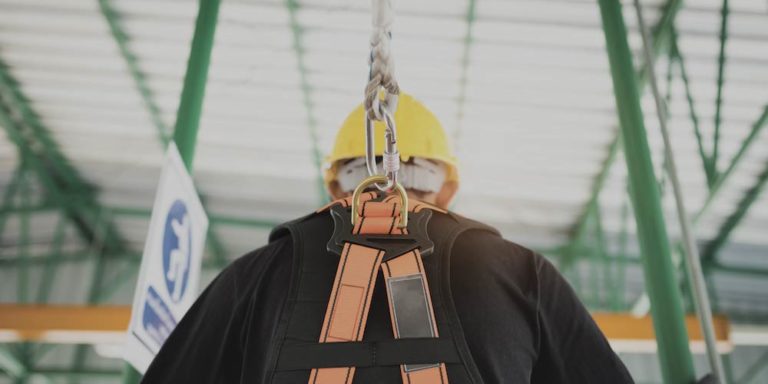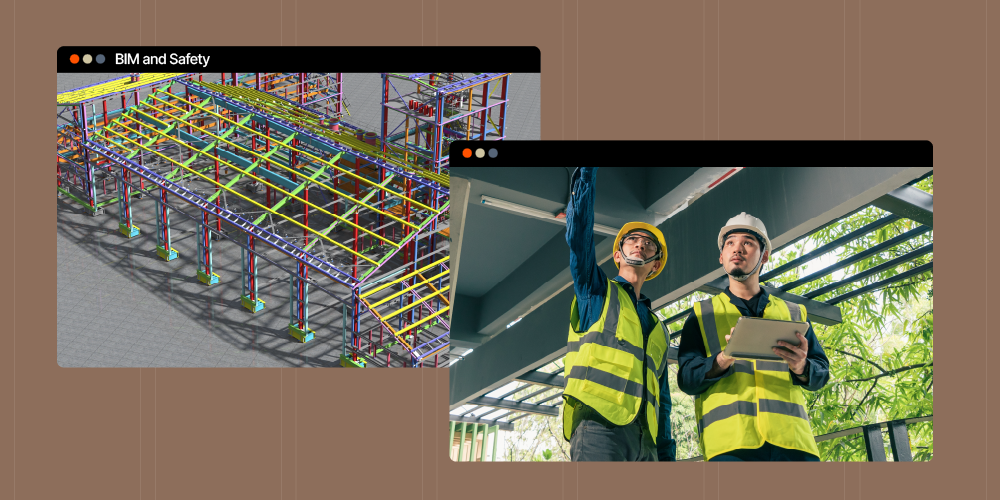— 9 min read
Top OSHA Violations in Construction (2021)
Last Updated Jun 12, 2024
Last Updated Jun 12, 2024

To those on the jobsite day-to-day, it’s no surprise that construction consistently tops the list of the most dangerous industries in the US. The Occupational Health and Safety Administration (OSHA) is the federal agency responsible for maintaining workplace safety across all industries. But because of the inherent dangers on construction jobsites, contractors are under close scrutiny for compliance. In this article, we’ll look at the top 10 violations found during OSHA inspections in 2021, the cost of OSHA violations, and how to prevent them.
More stats on safety: 36 Construction Safety Statistics for 2023
Table of contents
OSHA standards for construction
OSHA averages more than 30,000 inspections annually, including many unscheduled visits arising from employee complaints or injuries. These inspections lead to citations that include fines, especially for serious violations, failure to abate, or willful violations, which can range anywhere from $14,502 to $145,027 per violation.
Along with other construction laws, OSHA regulations seek to protect everyone working in the construction industry.
Although worker deaths in the United States have dropped on average in the past 50 years, the construction industry still reckons with around 1,000 deaths each year — a number that proper safety training and protocols can reduce.
“Construction is an inherently dangerous business,” says Peter Lindborg, a construction attorney based in Los Angeles, California. “Unfortunately, people get hurt on job sites every day, so it's something that always has to be top of mind. Well-run construction outfits always have a safety department or a director of safety.”
When it comes to construction, OSHA has two main groups of rules — called standards — that contractors must follow:
- Standard 1910: Occupational Safety and Health Standards
- Standard 1926: Safety and Health Regulations for Construction
While those two standards are the most commonly cited on construction jobsites, OSHA can issue a citation for a violation of any of its full list of regulations.
“OSHA regulation 1910.134 seems to be a popular violation and citation in connection with COVID-19 inspections,” says construction attorney JoLynn Scharrer. “Most of the violations relate to the failure to provide respiratory protection. For the past 18 months, there have been over $7 million in penalties levied across the country on COVID-19 inspections alone.”
Top 10 OSHA violations by contractors
1. Fall protection – 5,465 violations
- Citations: 5,465
- Inspections: 5,327
- Penalties: $28.8 million
Unsurprisingly, the most common OSHA violation in construction in 2021 was the failure to provide appropriate fall protection. It accounts for more than twice as many citations and over five times the financial penalties of any other violation.
According to OSHA Standard 1926.0501, all construction companies must provide fall protection. This standard includes guidance for specific scenarios, like covering open skylights or holes, providing guardrails on ramps or stairs, and a whole lot more.
2. Ladders – 2,096 violations
- Citations: 2,096
- Inspections: 1,782
- Penalties: $5.7 million
OSHA Standard 1926.1053 sets load limits, clearance guidelines, and other safety requirements for ladders on a jobsite. Many of the citations stem from improper use or unsafe setup of ladders — we’ve all seen workers jerry-rigging a ladder for something other than what it was designed for. This can be an expensive mistake; the average penalty for a ladder violation is nearly $3,000.
3. Scaffolding – 2,047 violations
- Citations: 2,047
- Inspections: 1,024
- Penalties: $2.9 million
According to OSHA standard 1926.451, each scaffold and scaffold component must be able to support its own weight and at least four times the maximum intended load.
4. Fall protection training – 1,687 violations
- Citations: 1,687
- Inspections: 1,626
- Penalties: $2.9 million
OSHA has a number of safety training requirements, and standard 1926.503 specifically requires construction companies to implement a fall protection training program to “enable each employee to recognize the hazards of falling and train each employee in the procedures to be followed in order to minimize these hazards.”
The organization takes this seriously: Fatal falls in construction account for one of every three construction worker deaths according to the Centers for Disease Control and Prevention (CDC).
5. Eye and face protection – 1,494 violations
- Citations: 1,494
- Inspections: 1,488
- Penalties: $4.8 million
Standard 1926.102 requires employees to wear “appropriate eye or face protection when exposed to eye or face hazards from flying particles, molten metal, liquid chemicals, acids or caustic liquids, chemical gases or vapors, or potentially injurious light radiation.”
6. Health and safety – 863 violations
- Citations: 863
- Inspections: 812
- Penalties: $3.5 million
OSHA standard 1926.20 prohibits contractors from requiring employees to work “in surroundings or under working conditions which are unsanitary, hazardous, or dangerous to his health or safety.” It also requires contractors to provide appropriate personal protective equipment (PPE) to all employees. Every worker who is not provided with PPE or required training is considered a separate violation, so they can add up quickly.
7. Head protection – 841 violations
- Citations: 841
- Inspections: 840
- Penalties: $2.4 million
This standard (1926.100) requires all employees to wear head protection anytime there is a risk of head injury from “impact, or from falling or flying objects, or from electrical shock and burns.” That’s pretty much every construction site where the building is above one story.
8. Excavation safety requirements – 549 violations
- Citations: 549
- Inspections: 337
- Penalties: $2.5 million
OSHA standard 1926.651 contains a laundry list of safety regulations for excavation activities. These include identifying underground utilities before digging (everyone should know 811, the national before-you-dig phone number), warning systems for heavy equipment, ventilation requirements, and more.
9. Aerial lifts – 534 violations
- Citations: 534
- Inspections: 486
- Penalties: $1.7 million
If you haven’t guessed by now, OSHA inspectors pay close attention when employees are at risk of falling. Standard 1926.453 establishes rules for aerial lifts, boom platforms, ladder trucks, and other similar equipment. The requirements include things like daily equipment testing, load limits, welding standards, and more.
10. Hazard communication – 531 violations
- Citations: 531
- Inspections: 252
- Penalties: $610,522
This standard (1910.1200) is part of OSHA’s general safety and health standards that aren’t specific to construction, but it still made the list of top violations by contractors. This section covers the classification and labeling of hazardous materials — and requires companies to communicate potential hazards and protective measures to employees.
The real cost of OSHA violations
OSHA citations do carry a financial penalty, but the fee itself is the least of a contractor’s worries. In the grand scheme of business operations, OSHA penalties for violations are relatively small, typically in the thousands of dollars. On a large commercial project, the accounting team may not bat an eye. Of course, on a small residential job, it could mean the difference between making a profit and ending up in the red.
The much bigger cause for financial concern is workers’ compensation insurance.
Workers’ compensation insurance
Because construction is a dangerous industry, workers’ compensation insurance is expensive even without an OSHA violation on your record. While OSHA’s penalty itself may motivate some contractors to change their safety practices, the threat of an increase in workers’ comp premiums is the biggest motivating factor to avoid them.
“Workers’ comp premiums for contractors tend to be astronomical at best,” Peter Lindborg says. “If you want to send your workers comp premiums into the stratosphere, collect a few OSHA violations. Pretty soon you'll be working for your workers’ comp carrier and not for yourself.”
Compliance cost
An OSHA citation includes both the reason for the violation and the corrective action you are required to take. In most cases, preventive measures will almost always be cheaper than corrective ones.
Schedule delays
OSHA has quite a bit of latitude when it comes to penalizing a safety violation. For first offenses or minor infractions, the contractor may get off with a fine. But if multiple OSHA violations pile up on a project, or corrective action isn’t taken, the inspector can shut down the jobsite.
“There's always a section on an OSHA citation that says ‘corrective action needed,’” says Lindborg. “If they come back three days later and nobody's done anything to fix it, then you're asking to get shut down.”
Shutdowns cause schedule delays, which can be incredibly expensive on their own. They will also frequently delay payments to everyone on the job — not just the contractor at fault.
Contract breaches
Many subcontract agreements include a clause that states the subcontractor is responsible for compliance with OSHA regulations and other safety measures. Getting cited by OSHA can cause a subcontractor to breach their contract with the GC.
“A decent subcontract is drafted so that the subcontractor is responsible for complying with OSHA regulations as it affects your scope of work and your people,” says Lindborg. “So the GC is going to turn around and look at the subcontractor and say, ‘This is your problem. Fix it. And pay the fine. And pay for whatever corrective action is needed.’”
Legal fees
Contractors can appeal violations to the Occupational Safety and Health Review Commission (OSHRC) through their local OSHA office.
“Any OSHA violation is a citation,” says Lindborg. “So to a certain extent, it's like a traffic ticket. Contractors have the right to appeal those citations to an administrative board.”
While you don’t necessarily need a construction lawyer during this process, they can help you weigh your chances of success through the process. “It's something of a regular part of our practice to do appeals of OSHA citations,” says Lindborg, “because the contractor genuinely believes that there's been a misclassification, or that there are some sort of mitigating circumstances.”
And if you want to appeal the OSHRC decision, you will need to take your suit to federal court. This will most definitely require the assistance of an experienced construction attorney – and the fees that come with them.
Of course, while Lindborg says the success rate at appealing OSHA violations is generally below 50%, the legal fees can still be worth it for the chance of avoiding a hike in workers’ comp premiums.
How to reduce OSHA violations
Establish a safety training program
Every construction company needs to have a special focus on safety. “Safety is independent of both cost and schedule,” says Peter Lindborg. “You do what you need to do to keep your people safe.”
OSHA Focus Four Training provides slide decks and instructor resources for preventing the four main causes of worker injury or fatalities on a jobsite. Training that focuses on ladder and scaffolding safety aims to reduce the number of fatal falls on construction sites.
Use safety software & apps on the jobsite
Give your field workers the tools they need to stay safe. In addition to PPE, there are a number of software platforms and smartphone apps that can provide real-time guidance and training to keep workers out of harm’s way.
- The NIOSH Ladder Safety app includes a ladder angle measuring tool and other jobsite guidance.
- Procore’s Site Quality & Safety Management software helps contractors reduce risk and predict safety issues on the jobsite.
- OSHA’s Heat Safety app calculates the heat index on the job and sends push notifications to remind workers to drink water, schedule rest breaks, and more.
Conduct your own safety audits & site inspections
Don’t wait for an OSHA inspector to visit your jobsite. Conduct routine safety audits and surprise site inspections on your own projects to ensure your workers in the field are following safety guidelines.
Watch: Safety Audits and Site Inspections webinar
This webinar is led by Edwin G. Foulke, Jr, the Assistant Secretary of Labor for Occupational Safety and Health from 2006 to 2008. During his tenure at OSHA, workplace injury, illness, and fatality rates dropped to their lowest levels in recorded history.
Was this article helpful?
Thank you for your submission.
100%
0%
You voted that this article was . Was this a mistake? If so, change your vote here.
Scroll less, learn more about construction.
Subscribe to The Blueprint, Procore’s construction newsletter, to get content from industry experts delivered straight to your inbox.
By clicking this button, you agree to our Privacy Notice and Terms of Service.
Categories:
Tags:
Written by
Daniel Gray
28 articles
Daniel is an educator and writer with a speciality in construction. He has been writing construction content for Procore since 2022, and previously served as a Procore Content Manager before continuing to pursue an education career as an Assistant Headmaster for Valor Education in Austin. Daniel's experience writing for construction — as well as several clients under an agency — has broadened his knowledge and expertise across multiple subjects.
View profileExplore more helpful resources

The Strategic Partnership Between Construction Safety and HR
A construction safety manager’s role is significant: It entails broad oversight over the construction workplace to prevent incidents that could cause worker injury or property damage. In addition to this...

Enhancing Construction Safety with BIM Technologies
The construction industry is no stranger to tools: Even ancient civilizations developed mallets and axes to make their work easier. Today’s latest tools look different, but they can be as instrumental...

Construction Safety Training – Goals, Benefits & Emerging Trends
Construction safety training (CST) educates workers about the risks they face on construction sites and teaches them how to prevent accidents, injuries and fatalities. The construction industry has the highest...

Technology for Construction Safety: Strategies to Supercharge and Scale Safety Practices
The construction industry is no stranger to the arrival of new technology, and builders are realizing its many benefits. Modernization across the industry is helping contractors streamline operations, enhance efficiency,...